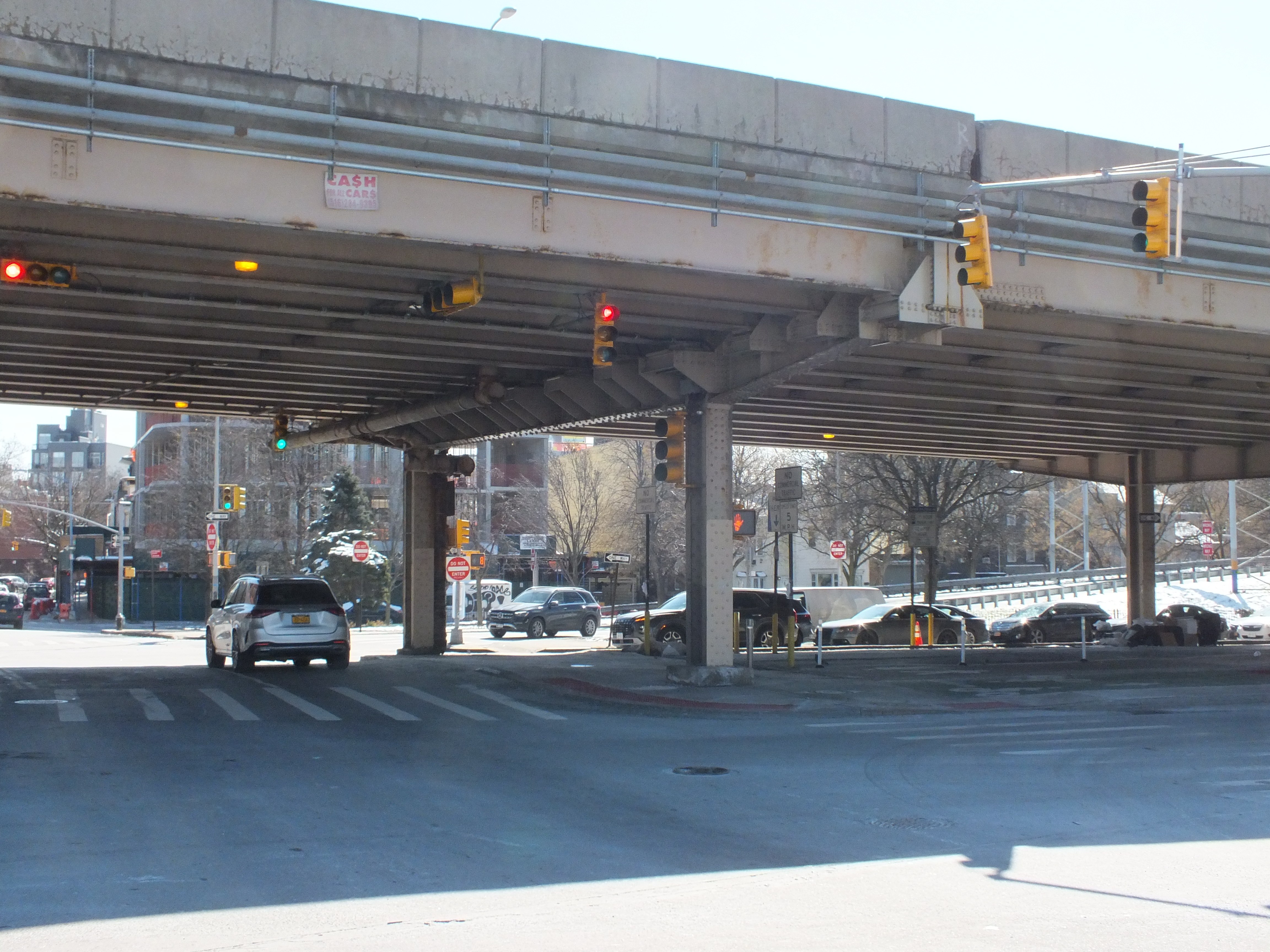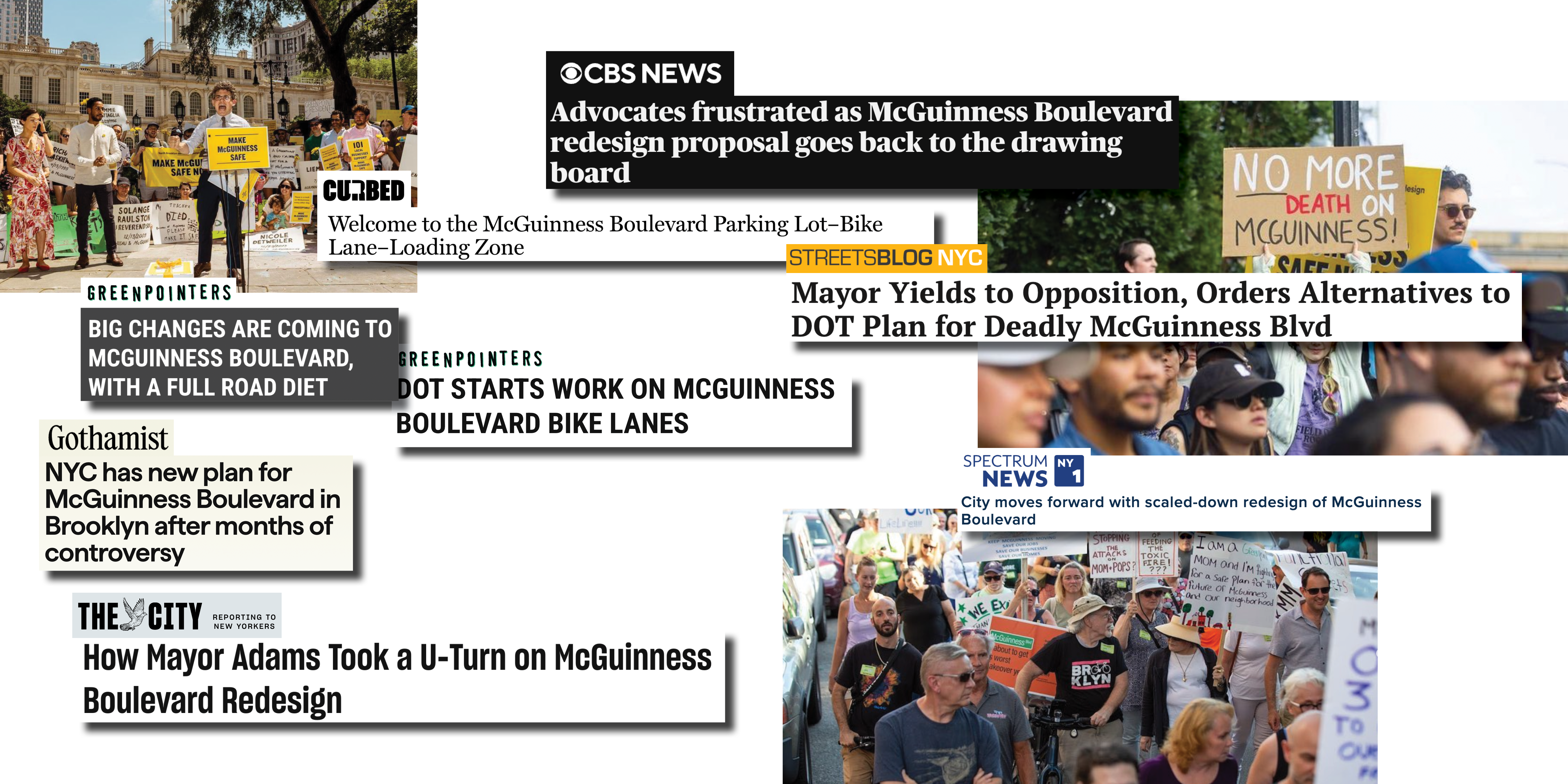Dangerous by Design: Assessing Urban Mobility and Traffic Safety along McGuinness Boulevard
Introduction
Ensuring the safety of our streets is a multifaceted endeavor that transcends mere infrastructural and political efforts – it is a complex landscape that weaves social, economic, design, and public health interests together. This case study explores how different modes of transportation interact within the built environment, and how policy and design informs both mobility and safety for these users. This research also highlights how private interests can eclipse public governance and collective needs with devastating effects on the safety and mobility of communities.
Our work focuses on the Greenpoint neighborhood in Brooklyn, at intersections along McGuinness Boulevard between Newtown Road and Meeker Avenue under the Brooklyn-Queens Expressway, and the intersection at Humboldt and Herbert Streets. Through animated maps, illustrations, and renderings, we have highlighted the shortcomings in street design and adequate investment at these locations to underscore the urgent need for improved traffic safety measures.
McGuinness Boulevard Vision Zero Improvements Map
 Source: Authors’ Own
Source: Authors’ Own
This project was conducted in collaboration with the Legal Aid Society and students at Fordham Law School. Through this multidisciplinary research, we have supported advocacy for sentence mitigation for Legal Aid Society clients through innovative methods, including the production of visual data narratives to enhance Legal Aid Society’s video mitigation projects. These video mitigation efforts aim for various judicial outcomes, including reduced sentences, case dismissals for justice, and advocating for release on recognizance rather than bail.
McGuinness Boulevard and Meeker Avenue Intersection

The Legal Aid Society
The Legal Aid Society, a nonprofit organization in the U.S., provides legal services to individuals and families with limited financial resources. Founded in 1876, the Legal Aid Society maintains several offices nationwide. The scope of their services encompasses legal representation in civil, criminal, and juvenile rights cases, as well as advocacy for structural changes that enhance fairness and justice within the legal system.
Presently, over 2 million people are incarcerated in the US – a 500% increase in the Legal Aid Society 40 years that can largely be credited to changes in sentencing policy and law, rather than rising crime rates (The Sentencing Project). Legal Aid Society’ work seeks to provide all clients with the right to equal justice and is committed to ending mass incarceration, which disproportionately affects low-income and marginalized individuals and communities in the United States.
From January to May 2024, our team engaged with the Legal Aid Society on one of their active cases about traffic safety. Our contributions involve working together to develop visual representations of street design concerns and crafting empathetic narratives for their client. The data used in creating these representations is confidential and is anonymized in our report.
Thematic Concerns
At the heart of our study lies the recognition that traffic accidents and collisions are not solely the result of individual actions. Understanding that inadequate road design creates hazardous conditions for all street users is crucial. This thematic argument is supported by foundational concepts from “The Safe Systems Pyramid: A New Framework for Traffic Safety” by Ederer et al., 2023, and the principles underpinning New York City’s Vision Zero initiative.
Ederer et al.’s research views road safety through a systemic lens, arguing that road accidents are typically the result of complex interactions between agents, hosts, and environmental conditions rather than just individual errors (Ederer et al., 2023). Their research critiques traditional safety frameworks that overly emphasize behavioral interventions and mistakenly place the burden of responsibility on individuals within the road environment. This perspective aligns with the public health approach that underpins the City’s Vision Zero effort, which contends that traffic-related deaths and severe injuries are preventable and that no loss of life on the roads is acceptable.
Since its implementation in 2014, Vision Zero has aimed to eliminate traffic fatalities through comprehensive strategies, including engineering improvements, traffic law enforcement, and public education. The city’s efforts have led to some of the safest years on record, yet the initiative’s success hinges on continual innovation and rigorous evaluation.
McGuinness Boulevard Collisions Resulting in Injured Persons from 2019 to 2024 Map
 Source: Authors’ Own
Source: Authors’ Own
This approach gains particular relevance in the focal intersection of Meeker Avenue and McGuinness Boulevard—an area historically neglected regarding safety enhancements despite being recognized as one of the borough’s most dangerous. A proposed redesign of McGuinness Boulevard, which included protected bike lanes aimed at improving safety for micro-mobility users, was initially supported but ultimately abandoned due to opposition from private interests and Mayor Eric Adams’ aide, Ingrid Lewis-Martin. This decision, which contradicted previous approvals and grassroots advocacy for the redesign, has drawn criticism and raised concerns about the commitment to future safety improvements in the area.
News Coverage
 Sources: CBS News, Curbed, Gothamist, Greenpointers, Greenpointers, Spectrum News, Streetsblog NYC, The City
Sources: CBS News, Curbed, Gothamist, Greenpointers, Greenpointers, Spectrum News, Streetsblog NYC, The City
In examining these dynamics, our research aims to illuminate how existing street conditions and systemic failures in implementing safety measures exacerbate circumstances on the road. This thematic exploration underscores the need for a holistic approach to road safety that transcends individual blame and focuses on systemic changes to prevent such tragedies. This approach is not just a theoretical proposition but a practical necessity, as outlined in the cited works and the ongoing debates around Vision Zero’s implementation and challenges.
Furthermore, we have crafted narratives illuminating the design and urban challenges the Legal Aid Society’s client faces. We aim to bolster the Legal Aid Society’s mission of delivering justice and legal representation to underprivileged and economically disadvantaged groups, especially by highlighting mitigating circumstances in their legal proceedings. Our contributions are designed to make a tangible impact on the video mitigation cases for clients. We also aspire for our outward-facing initiatives to foster wider conversations about restorative justice and to promote movements toward ending mass incarceration.
Methods
The intersection analysis methodology incorporates a mixed-methods approach of three key components: historical analysis, streetscape mapping, and 3D model reconstruction.
-
Historical Analysis: This initial phase focuses on reviewing past incidents and collisions at the location and any efforts historically made to enhance safety in the area. We gathered insights into recurring problems and identified opportunities for improvement, providing a contextual foundation for the subsequent stages of analysis.
-
Streetscape Mapping: The second component involves creating a comprehensive map of the site and its immediate environment. This detailed mapping pinpoints critical street elements such as road markings, sidewalks, and the sites of previous accidents. This visual documentation is crucial for understanding the spatial and environmental factors contributing to the site’s safety issues.
-
3D Model Reconstruction: The final element of our methodology utilizes 3D modeling to bring a three-dimensional perspective to the analysis. This reconstruction includes critical features such as elevation changes, traffic signal locations, and nearby structures. By simulating the physical context of the street and accident site, this model highlights systemic design flaws that increase the risk and frequency of accidents. The model also recreates street elements that may have contributed to the accident, including placeholders for pedestrians and vehicles. Lastly, layering the various built environment elements may illuminate the site’s critical details and environmental conditions.
Case
The focal point of this case is a hazardous intersection of Meeker Avenue and McGuinness Boulevard in Brooklyn. It lacks crucial safety features for the protection of pedestrians and motorists. Notable issues at this site include an absence of marked pedestrian crossings, inadequate street lighting that diminishes visibility during nighttime hours, and traffic signals that need to be better positioned on an overhead flyover, making them difficult for drivers to see. Additionally, the design of the parking access under the bridge is fraught with hazards, lacking distinct signals and clear signage. This intersection also needs better timed traffic lights, which do not allow enough time for safe pedestrian crossings. Despite installing bollards intended to protect designated bike lanes, the absence of proper lane markings and intersection-specific safety measures has led to severe, sometimes fatal, accidents. This case underscores the pressing need for a comprehensive overhaul of safety protocols at this intersection to enhance urban traffic safety effectively.
Video
Source: Authors’ Own
Takeaways
-
Advocacy and Legal Support through Legal Aid Society: Collaboration with the Legal Aid Society has underscored the importance of supporting legal advocacy for traffic-related issues. Our contributions include creating visual narratives that effectively argue for judicial leniency, demonstrating society’s role in bridging justice and public safety.
-
A Systemic View on Traffic Safety: Traffic incidents must be recognized as outcomes of systemic issues, not individual errors. The case illustrates the need for a public health approach, advocating for policy reforms and comprehensive urban planning to enhance road safety.
-
Continuous Improvement in Safety Initiatives: Vision Zero’s aim to eliminate traffic fatalities highlights the necessity of ongoing innovation and community involvement to overcome challenges in implementing safety measures, particularly in complex urban settings like the Meeker Avenue and McGuinness Boulevard intersection.
-
Urgent Need for Strategic Safety Overhauls: Investigations into intersection safety reveal dire needs for comprehensive improvements. Our findings support the need for integrated safety measures to safeguard all road users.
-
Privacy and Data Integrity in Legal Cases: Handling sensitive data with the utmost confidentiality is crucial, particularly when publicizing geospatial information. Ensuring that all shared data preserves the anonymity and security of the individuals involved is paramount.
-
Accuracy and Completeness of Case Data: The complexity of the cases managed by the Legal Aid Society requires that all utilized data be current and thorough to support case narratives and legal strategies accurately.
-
Collaborative Communication with Diverse Professionals: Effective partnerships with various professionals demand clear communication and mutual understanding to ensure that all project outputs are practical, accessible, and meet the varied needs of all project stakeholders.
Bibliography
Chang, Clio. 2023. “Welcome to the McGuinness Boulevard Parking Lot–Bike Lane–Loading Zone.” Curbed. October 27, 2023. https://www.curbed.com/2023/10/mcguinness-boulevard-compromise-bike-lane.html.
Davey, Emma. 2023. ‘McGuinness Boulevard Driver Causes Severe Injuries and Damages Multiple Cars’. Greenpointers. August 11, 2023. https://greenpointers.com/2023/08/11/mcguinness-boulevard-driver-causes-severe-injuries-and-damages-multiple-cars/.
Davey, Emma. 2023. “DOT Starts Work on McGuinness Boulevard Bike Lanes.” Greenpointers. October 2, 2023. https://greenpointers.com/2023/10/02/dot-starts-work-on-mcguinness-boulevard-bike-lanes/.
Duggan , Kevin. 2023. “Outrage on Bloody McGuinness Blvd. as Motorist Severely Injures Moped Rider.” Streetsblog New York City. August 10, 2023. https://nyc.streetsblog.org/2023/08/10/outrage-on-deadly-mcguinness-blvd-as-motorist-severely-injures-moped-rider.
Ederer, David J., Rachael Thompson Panik, Nisha Botchwey, and Kari Watkins. 2023. “The Safe Systems Pyramid: A New Framework for Traffic Safety.” Transportation Research Interdisciplinary Perspectives 21 (September): 100905. https://doi.org/10.1016/j.trip.2023.100905.
Hogan, Gwynne. 2023. “How Mayor Adams Took a U-Turn on McGuinness Boulevard Redesign.” THE CITY - NYC News. July 6, 2023. http://www.thecity.nyc/2023/07/06/argento-eric-adams-mcguinness-redesign/.
“Make McGuinness Safe.” n.d. Instagram. Accessed March 6, 2024. https://www.instagram.com/makemcguinnesssafe/.
New York City Department of City Planning. 2024. “Digital City Map – Shapefile.” Shapefile. New York City Open Data. https://data.cityofnewyork.us/City-Government/Digital-City-Map-Shapefile/m2vu-mgzw.
New York City Department of Transportation. 2022. “McGuinness Complete Street Redesign.” June 30. https://www.nyc.gov/html/dot/downloads/pdf/mcguinness-blvd-complete-street-jun2022.pdf.
New York City Department of Transportation. 2024. “VZV_Street Improvement Projects (SIPs) Corridor.” Shapefile. New York City Open Data. https://data.cityofnewyork.us/Transportation/VZV_Street-Improvement-Projects-SIPs-Corridor/wqhs-q6wd.
New York City Department of Transportation. 2024. “VZV_Street Improvement Projects (SIPs) Intersections.” Shapefile. New York City Open Data. https://data.cityofnewyork.us/Transportation/VZV_Street-Improvement-Projects-SIPs-intersections/79sh-heg3.
New York Police Department. 2021. “Motor Vehicle Collisions - Crashes.” Dataset. New York City Open Data. https://data.cityofnewyork.us/Public-Safety/Motor-Vehicle-Collisions-Crashes/h9gi-nx95/about_data.
New York Police Department. 2019. “Motor Vehicle Collisions - Person.” Dataset. New York City Open Data. https://data.cityofnewyork.us/Public-Safety/Motor-Vehicle-Collisions-Person/f55k-p6yu/about_data.
Paolicelli, Alyssa. 2023. “City Moves Forward with Scaled-down Redesign of McGuinness Boulevard.” Spectrum News NY1. August, 17 2023. https://ny1.com/nyc/all-boroughs/news/2023/08/17/dot-moves-forward-with-scaled-down-redesign-of-mcguiness-boulevard.
“Research - Get the Facts.” 2022. The Sentencing Project. September 8, 2022. https://www.sentencingproject.org/research/.
Simpson, David. McGuiness Boulevard and Meeker Avenue Intersection. February 18, 2024. The Legal Aid Society.
The Legal Aid Society. “What We Do Archive.” n.d. The Legal Aid Society (blog). Accessed March 6, 2024. https://legalaidnyc.org/what-we-do/.
“Vision Zero.” n.d. NYC Vision Zero. City of New York. Accessed March 6, 2024. https://www.nyc.gov/content/visionzero/pages/.